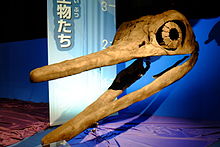Shonisaurus
| Shonisaurus Temporal range:
| |
|---|---|

| |
| Restored skull in a Japanese museum | |
| Scientific classification | |
| Domain: | Eukaryota |
| Kingdom: | Animalia |
| Phylum: | Chordata |
| Class: | Reptilia |
| Order: | †Ichthyosauria |
| Family: | †Shastasauridae |
| Genus: | †Shonisaurus Camp, 1976 |
| Type species | |
| †Shonisaurus popularis Camp, 1976
| |
| Species[1][2] | |
| |
Shonisaurus is a genus of very large
Description


Shonisaurus lived during the late Carnian to Norian stages of the Late Triassic. With a large skull about 2.75 m (9.0 ft) long, S. popularis and measured around 13.5–15 metres (44–49 ft) in length and 21.6–29.7 metric tons (23.8–32.7 short tons) in body mass.[5][6] S. sikanniensis was one of the largest marine reptiles of all time, measuring 21 metres (69 ft) and weighing 81.5 metric tons (89.8 short tons).[5]
Shonisaurus had a long snout, and its flippers were much longer and narrower than in other ichthyosaurs. While Shonisaurus was initially reported to have had socketed teeth (rather than teeth set in a groove as in more advanced forms), these were present only at the jaw tips, and only in the very smallest, juvenile specimens. All of these features suggest that Shonisaurus may be a relatively specialised offshoot of the main ichthyosaur evolutionary line.[7] More recent finds however indicate that Shonisaurus possessed teeth in all ontogenetic stages.[8] Robust sectorial teeth and gut contents indicate that Shonisaurus was a macrophagous raptorial predator which fed on vertebrates and shelled mollusks like cephalopods, possibly even large-bodied prey.[9][10] Additionally, Shonisaurus was historically depicted with a rather rotund body, but studies of its body shape since the early 1990s have shown that the body was much more slender than traditionally thought,[11] and had a relatively deep body compared with related marine reptiles.[2]
History of discovery

Fossils of Shonisaurus were first found in a large deposit in Nevada in 1920. Thirty years later, they were excavated, uncovering the remains of 37 very large ichthyosaurs. These were named Shonisaurus, which means "lizard from the Shoshone Mountains", after the formation where the fossils were found.
S. popularis, was adopted as the
A second species from the
Specimens belonging to S. sikanniensis have been found in the
See also
- Largest prehistoric organisms
- Shastasaurus, a relative of and what used to be classified as a species of Shonisaurus
- Temnodontosaurus, another large ichthyosaur
- List of ichthyosaurs
- Timeline of ichthyosaur research
Notes
- .
- ^ ISSN 0272-4634.
- .
- ^ .
- ^ S2CID 245444783.
- .
- ISBN 1-84028-152-9.
- ^ Kelley, Neil P.; Irmis, Randall; Rasmussen, Cornelia; Depolo, Paige E.; Pyenson, Nicholas (2016). "Beyond the Shonisaurus Death Cult: New Insights into the Ecology and Life History of the Earliest Gigantic Marine Tetrapod". 76th Annual Meeting of the Society of Vertebrate Paleontology, Salt Lake City: 587. Retrieved 27 September 2021.
- S2CID 254874088.
- S2CID 129908740.
- .
- ISBN 0-520-23315-8.
- PMID 21625429.
- S2CID 83784699.
- ^ Moon, B. (2019). "A new phylogeny of ichthyosaurs (Reptilia: Diapsida)". Journal of Systematic Palaeontology. 17: 1–27.
- hdl:11573/1682932.
- .
References
- Dixon, Dougal. "The Complete Book of Dinosaurs." Hermes House, 2006.
- Camp, C. L. (1980). "Large ichthyosaurs from the Upper Triassic of Nevada". Palaeontographica, Abteilung A. 170: 139–200.
- Camp, C.L. 1981. Child of the rocks, the story of Berlin-Ichthyosaur State Park. Nevada Bureau of Mines and Geology special publication 5.
- Cowen, R. 1995. History of life. Cambridge, Massachusetts: Blackwell Scientific.
- Hogler, J. A. (1992). "Taphonomy and Paleoecology of Shonisaurus popularis (Reptilia: Ichthyosauria)". PALAIOS. 7 (1): 108–117. JSTOR 3514800.
- McGowan, Chris; Motani, Ryosuke (1999). "A reinterpretation of the Upper Triassic ichthyosaurShonisaurus". Journal of Vertebrate Paleontology. 19: 42–49. .
- Motani, Ryosuke; Minoura, Nachio; Ando, Tatsuro (1998). "Ichthyosaurian relationships illuminated by new primitive skeletons from Japan". Nature. 393 (6682): 255–257. S2CID 4416186.
